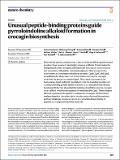Files in this item
Unusual peptide-binding proteins guide pyrroloindoline alkaloid formation in crocagin biosynthesis
Item metadata
| dc.contributor.author | Adam, Sebastian | |
| dc.contributor.author | Zheng, Dazhong | |
| dc.contributor.author | Klein, Andreas | |
| dc.contributor.author | Volz, Carsten | |
| dc.contributor.author | Mullen, William | |
| dc.contributor.author | Shirran, Sally L. | |
| dc.contributor.author | Smith, Brian O. | |
| dc.contributor.author | Kalinina, Olga V. | |
| dc.contributor.author | Müller, Rolf | |
| dc.contributor.author | Koehnke, Jesko | |
| dc.date.accessioned | 2023-04-05T10:30:08Z | |
| dc.date.available | 2023-04-05T10:30:08Z | |
| dc.date.issued | 2023-04-01 | |
| dc.identifier | 283994958 | |
| dc.identifier | e201bcb3-3de7-4e00-87b6-3b755c0323b9 | |
| dc.identifier | 85149459257 | |
| dc.identifier.citation | Adam , S , Zheng , D , Klein , A , Volz , C , Mullen , W , Shirran , S L , Smith , B O , Kalinina , O V , Müller , R & Koehnke , J 2023 , ' Unusual peptide-binding proteins guide pyrroloindoline alkaloid formation in crocagin biosynthesis ' , Nature Chemistry , vol. 15 , no. 4 , pp. 560-568 . https://doi.org/10.1038/s41557-023-01153-w | en |
| dc.identifier.issn | 1755-4330 | |
| dc.identifier.other | Jisc: 1000566 | |
| dc.identifier.other | publisher-id: s41557-023-01153-w | |
| dc.identifier.other | manuscript: 1153 | |
| dc.identifier.other | ORCID: /0000-0003-3516-3507/work/132764188 | |
| dc.identifier.uri | https://hdl.handle.net/10023/27337 | |
| dc.description | Funding: This work was supported by the European Research Council (Consolidator Grant 101002326 to J.K.). | en |
| dc.description.abstract | Ribosomally synthesized and post-translationally modified peptide natural products have provided many highly unusual scaffolds. This includes the intriguing alkaloids crocagins, which possess a tetracyclic core structure and whose biosynthesis has remained enigmatic. Here we use in vitro experiments to demonstrate that three proteins, CgnB, CgnC and CgnE, are sufficient for the production of the hallmark tetracyclic crocagin core from the precursor peptide CgnA. The crystal structures of the homologues CgnB and CgnE reveal them to be the founding members of a peptide-binding protein family and allow us to rationalize their distinct functions. We further show that the hydrolase CgnD liberates the crocagin core scaffold, which is subsequently N-methylated by CgnL. These insights allow us to propose a biosynthetic scheme for crocagins. Bioinformatic analyses based on these data led to the discovery of related biosynthetic pathways that may provide access to a structurally diverse family of peptide-derived pyrroloindoline alkaloids. | |
| dc.format.extent | 9 | |
| dc.format.extent | 3315721 | |
| dc.language.iso | eng | |
| dc.relation.ispartof | Nature Chemistry | en |
| dc.subject | QD Chemistry | en |
| dc.subject | DAS | en |
| dc.subject | MCC | en |
| dc.subject.lcc | QD | en |
| dc.title | Unusual peptide-binding proteins guide pyrroloindoline alkaloid formation in crocagin biosynthesis | en |
| dc.type | Journal article | en |
| dc.contributor.institution | University of St Andrews. Arctic Research Centre | en |
| dc.contributor.institution | University of St Andrews. School of Biology | en |
| dc.contributor.institution | University of St Andrews. Institute of Behavioural and Neural Sciences | en |
| dc.contributor.institution | University of St Andrews. Biomedical Sciences Research Complex | en |
| dc.identifier.doi | https://doi.org/10.1038/s41557-023-01153-w | |
| dc.description.status | Peer reviewed | en |
This item appears in the following Collection(s)
Items in the St Andrews Research Repository are protected by copyright, with all rights reserved, unless otherwise indicated.

